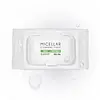What's inside
What's inside
 Key Ingredients
Key Ingredients

No key ingredients
 Benefits
Benefits

 Concerns
Concerns

 Ingredients Side-by-side
Ingredients Side-by-side

Water
Skin ConditioningGlycerin
HumectantPEG-6 Caprylic/Capric Glycerides
EmulsifyingPropanediol
Solvent1,2-Hexanediol
Skin ConditioningHydroxyacetophenone
AntioxidantPolyglyceryl-4 Caprate
EmulsifyingSodium Citrate
BufferingDisodium EDTA
Ethylhexylglycerin
Skin ConditioningCitric Acid
BufferingMelaleuca Alternifolia Leaf Oil
AntioxidantOlea Europaea Fruit Oil
MaskingButylene Glycol
HumectantHouttuynia Cordata Extract
Skin ConditioningVigna Radiata Seed Extract
Skin ConditioningXylitylglucoside
HumectantBeta-Glucan
Skin ConditioningAnhydroxylitol
HumectantXylitol
HumectantHelichrysum Arenarium Extract
AntiseborrhoeicGlucose
HumectantPentylene Glycol
Skin ConditioningPrunus Persica Flower Extract
MoisturisingOrchid Extract
Skin ConditioningCaprylyl Glycol
EmollientWater, Glycerin, PEG-6 Caprylic/Capric Glycerides, Propanediol, 1,2-Hexanediol, Hydroxyacetophenone, Polyglyceryl-4 Caprate, Sodium Citrate, Disodium EDTA, Ethylhexylglycerin, Citric Acid, Melaleuca Alternifolia Leaf Oil, Olea Europaea Fruit Oil, Butylene Glycol, Houttuynia Cordata Extract, Vigna Radiata Seed Extract, Xylitylglucoside, Beta-Glucan, Anhydroxylitol, Xylitol, Helichrysum Arenarium Extract, Glucose, Pentylene Glycol, Prunus Persica Flower Extract, Orchid Extract, Caprylyl Glycol
Water
Skin ConditioningBetaine
HumectantPolyglyceryl-4 Caprate
EmulsifyingGlycerin
HumectantIsopentyldiol
HumectantCapryl/Capramidopropyl Betaine
CleansingCaprylyl Glycol
EmollientEthylhexylglycerin
Skin ConditioningEthyl Lauroyl Arginate Hcl
Skin ConditioningMaris Sal
Skin ConditioningPolyglyceryl-3 Cocoate
EmulsifyingPolyglyceryl-6 Caprate
CleansingPolyglyceryl-6 Ricinoleate
EmulsifyingSodium Carrageenan
Emulsion StabilisingSodium Chloride
MaskingSodium Citrate
BufferingCitric Acid
BufferingIodopropynyl Butylcarbamate
PreservativePhenoxyethanol
PreservativeSodium Benzoate
MaskingWater, Betaine, Polyglyceryl-4 Caprate, Glycerin, Isopentyldiol, Capryl/Capramidopropyl Betaine, Caprylyl Glycol, Ethylhexylglycerin, Ethyl Lauroyl Arginate Hcl, Maris Sal, Polyglyceryl-3 Cocoate, Polyglyceryl-6 Caprate, Polyglyceryl-6 Ricinoleate, Sodium Carrageenan, Sodium Chloride, Sodium Citrate, Citric Acid, Iodopropynyl Butylcarbamate, Phenoxyethanol, Sodium Benzoate
Ingredients Explained
These ingredients are found in both products.
Ingredients higher up in an ingredient list are typically present in a larger amount.
Caprylyl Glycol is a humectant and emollient, meaning it attracts and preserves moisture.
It is a common ingredient in many products, especially those designed to hydrate skin. The primary benefits are retaining moisture, skin softening, and promoting a healthy skin barrier.
Though Caprylyl Glycol is an alcohol derived from fatty acids, it is not the kind that can dry out skin.
This ingredient is also used as a preservative to extend the life of products. It has slight antimicrobial properties.
Learn more about Caprylyl GlycolCitric Acid is an alpha hydroxy acid (AHA) naturally found in citrus fruits like oranges, lemons, and limes.
Like other AHAs, citric acid can exfoliate skin by breaking down the bonds that hold dead skin cells together. This helps reveal smoother and brighter skin underneath.
However, this exfoliating effect only happens at high concentrations (20%) which can be hard to find in cosmetic products.
Due to this, citric acid is usually included in small amounts as a pH adjuster. This helps keep products slightly more acidic and compatible with skin's natural pH.
In skincare formulas, citric acid can:
While it can provide some skin benefits, research shows lactic acid and glycolic acid are generally more effective and less irritating exfoliants.
Most citric acid used in skincare today is made by fermenting sugars (usually from molasses). This synthetic version is identical to the natural citrus form but easier to stabilize and use in formulations.
Read more about some other popular AHA's here:
Learn more about Citric AcidEthylhexylglycerin (we can't pronounce this either) is commonly used as a preservative and skin softener. It is derived from glyceryl.
You might see Ethylhexylglycerin often paired with other preservatives such as phenoxyethanol. Ethylhexylglycerin has been found to increase the effectiveness of these other preservatives.
Glycerin is already naturally found in your skin. It helps moisturize and protect your skin.
A study from 2016 found glycerin to be more effective as a humectant than AHAs and hyaluronic acid.
As a humectant, it helps the skin stay hydrated by pulling moisture to your skin. The low molecular weight of glycerin allows it to pull moisture into the deeper layers of your skin.
Hydrated skin improves your skin barrier; Your skin barrier helps protect against irritants and bacteria.
Glycerin has also been found to have antimicrobial and antiviral properties. Due to these properties, glycerin is often used in wound and burn treatments.
In cosmetics, glycerin is usually derived from plants such as soybean or palm. However, it can also be sourced from animals, such as tallow or animal fat.
This ingredient is organic, colorless, odorless, and non-toxic.
Glycerin is the name for this ingredient in American English. British English uses Glycerol/Glycerine.
Learn more about GlycerinPolyglyceryl-4 Caprate comes from Capric Acid and Polyglycerin-4. It is an emulsifier.
Emulsifiers help stabilize a product. They do this by preventing ingredients from separating, such as oils and water which do not mix naturally.
Sodium Citrate is the sodium salts of citric acid. In skincare, it is used to alter pH levels and acts as a preservative.
Its main functions are to maintain the pH of a product and neutralize metal ions.
The acidity of our skin is maintained by our glands and skin biome; normal pH level of skin is slightly acidic (~4.75-5.5).
Being slightly acidic allows our skin to create an "acid mantle". This acid mantle is a thin barrier that protects our skin from bacteria and contaminants.
Learn more about Sodium CitrateWater. It's the most common cosmetic ingredient of all. You'll usually see it at the top of ingredient lists, meaning that it makes up the largest part of the product.
So why is it so popular? Water most often acts as a solvent - this means that it helps dissolve other ingredients into the formulation.
You'll also recognize water as that liquid we all need to stay alive. If you see this, drink a glass of water. Stay hydrated!
Learn more about Water